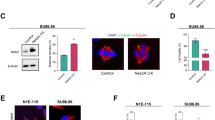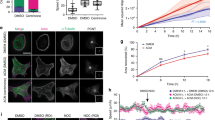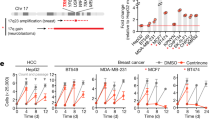Abstract
Many cancer cells contain more than two centrosomes, which imposes a potential for multipolar mitoses, leading to cell death. To circumvent this, cancer cells develop mechanisms to cluster supernumerary centrosomes to form bipolar spindles, enabling successful mitosis. Disruption of centrosome clustering thus provides a selective means of killing supernumerary centrosome-harboring cancer cells. Although the mechanisms of centrosome clustering are poorly understood, recent genetic analyses have identified requirements for both actin and tubulin regulating proteins. In this study, we demonstrate that the integrin-linked kinase (ILK), a protein critically involved in actin and mitotic microtubule organization, is required for centrosome clustering. Inhibition of ILK expression or activity inhibits centrosome clustering in several breast and prostate cancer cell lines that have centrosome amplification. Furthermore, cancer cells with supernumerary centrosomes are significantly more sensitive to ILK inhibition than cells with two centrosomes, demonstrating that inhibiting ILK offers a selective means of targeting cancer cells. Live cell analysis shows ILK perturbation leads cancer cells to undergo multipolar anaphases, mitotic arrest and cell death in mitosis. We also show that ILK performs its centrosome clustering activity in a focal adhesion-independent, but centrosome-dependent, manner through the microtubule regulating proteins TACC3 and ch-TOG. In addition, we identify a specific TACC3 phosphorylation site that is required for centrosome clustering and demonstrate that ILK regulates this phosphorylation in an Aurora-A-dependent manner.
This is a preview of subscription content, access via your institution
Access options
Subscribe to this journal
Receive 50 print issues and online access
$259.00 per year
only $5.18 per issue
Buy this article
- Purchase on Springer Link
- Instant access to full article PDF
Prices may be subject to local taxes which are calculated during checkout







Similar content being viewed by others
References
Albee AJ, Wiese C . (2008). Xenopus TACC3/maskin is not required for microtubule stability but is required for anchoring microtubules at the centrosome. Mol Biol Cell 19: 3347–3356.
Barr AR, Gergely F . (2008). MCAK-independent functions of ch-Tog/XMAP215 in microtubule plus-end dynamics. Mol Cell Biol 28: 7199–7211.
Barros TP, Kinoshita K, Hyman AA, Raff JW . (2005). Aurora A activates D-TACC-Msps complexes exclusively at centrosomes to stabilize centrosomal microtubules. J Cell Biol 170: 1039–1046.
Basto R, Brunk K, Vinadogrova T, Peel N, Franz A, Khodjakov A et al. (2008). Centrosome amplification can initiate tumorigenesis in flies. Cell 133: 1032–1042.
Bettencourt-Dias M, Giet R, Sinka R, Mazumdar A, Lock WG, Balloux F et al. (2004). Genome-wide survey of protein kinases required for cell cycle progression. Nature 432: 980–987.
Boveri T . (1914). Zur frage der entstehung maligner tumoren (The Origin of Malignant Tumors). Gustav Fischer, Jena.
Brinkley BR . (2001). Managing the centrosome numbers game: from chaos to stability in cancer cell division. Trends in Cell Biology 11: 18–21.
Cassimeris L, Morabito J . (2004). TOGp, the human homolog of XMAP215/Dis1, is required for centrosome integrity, spindle pole organization, and bipolar spindle assembly. Mol Biol Cell 15: 1580–1590.
Dobreva I, Fielding A, Foster LJ, Dedhar S . (2008). Mapping the integrin-linked kinase interactome using SILAC. J Proteome Res 7: 1740–1749.
Edwards LA, Woo J, Huxham LA, Verreault M, Dragowska WH, Chiu G et al. (2008). Suppression of VEGF secretion and changes in glioblastoma multiforme microenvironment by inhibition of Integrin-linked kinase (ILK). Mol Cancer Ther 7: 59–70.
Fielding AB, Dobreva I, McDonald PC, Foster LJ, Dedhar S . (2008). Integrin-linked kinase localizes to the centrosome and regulates mitotic spindle organization. J Cell Biol 180: 681–689.
Franken NAP, Rodermond HM, Stap J, Haveman J, van Bree C . (2006). Clonogenic assay of cells in vitro. Nature Protocols 1: 2315–2319.
Ganem NJ, Godinho SA, Pellman D . (2009). A mechanism linking extra centrosomes to chromosomal instability. Nature 460: 278–U146.
Gergely F, Draviam VM, Raff JW . (2003). The ch-TOG/XMAP215 protein is essential for spindle pole organization in human somatic cells. Genes Dev 17: 336–341.
Giet R, McLean D, Descamps S, Lee MJ, Raff JW, Prigent C et al. (2002). Drosophila Aurora A kinase is required to localize D-TACC to centrosomes and to regulate astral microtubules. J Cell Biol 156: 437–451.
Gkretsi V, Mars WM, Bowen WC, Barua L, Yang Y, Guo L et al. (2007). Loss of integrin linked kinase from mouse hepatocytes in vitro and in vivo results in apoptosis and hepatitis. Hepatology 45: 1025–1034.
Guidotti JE, Bregerie O, Robert A, Debey P, Brechot C, Desdouets C . (2003). Liver cell polyploidization: A pivotal role for binuclear hepatocytes. J Biol Chem 278: 19095–19101.
Hannigan G, Troussard AA, Dedhar S . (2005). Integrin-linked kinase: A cancer therapeutic target unique among its ILK. Nat Rev Cancer 5: 51–63.
Kinoshita K, Noetzel TL, Pelletier L, Mechtler K, Drechsel DN, Schwager A et al. (2005). Aurora A phosphorylation of TACC3/maskin is required for centrosome-dependent microtubule assembly in mitosis. J Cell Biol 170: 1047–1055.
Koul D, Shen R, Bergh S, Lu Y, de Groot JF, Liu TJ et al. (2005). Targeting integrin-linked kinase inhibits Akt signaling pathways and decreases tumor progression of human glioblastoma. Mol Cancer Ther 4: 1681–1688.
Kramer A, Neben K, Ho AD . (2002). Centrosome replication, genomic instability and cancer. Leukemia 16: 767–775.
Kwon M, Godinho SA, Chandhok NS, Ganem NJ, Azioune A, Thery M et al. (2008). Mechanisms to suppress multipolar divisions in cancer cells with extra centrosomes. Genes Dev 22: 2189–2203.
Lee MJ, Gergely F, Jeffers K, Peak-Chew SY, Raff JW . (2001). Msps/XMAP215 interacts with the centrosomal protein D-TACC to regulate microtubule behaviour. Nat Cell Biol 3: 643–649.
Legate KR, Montanez E, Kudlacek O, Fassler R . (2006). ILK, PINCH and parvin: the tIPP of integrin signalling. Nat Rev Mol Cell Biol 7: 20–31.
LeRoy PJ, Hunter JJ, Hoar KM, Burke KE, Shinde V, Ruan J et al. (2007). Localization of human TACC3 to mitotic spindles is mediated by phosphorylation on Ser558 by aurora A: A novel pharmacodynamic method for measuring aurora a activity. Cancer Res 67: 5362–5370.
Lingle WL, Barrett SL, Negron VC, D′Assoro AB, Boeneman K, Liu W et al. (2002). Centrosome amplification drives chromosomal instability in breast tumor development. Proceedings of the National Academy of Sciences of the USA 99: 1978–1983.
Lingle WL, Salisbury JL . (1999). Altered centrosome structure is associated with abnormal mitoses in human breast tumors. Am J Pathol 155: 1941–1951.
Margall-Ducos G, Celton-Morizur S, Couton D, Bregerie O, Desdouets C . (2007). Liver tetraploidization is controlled by a new process of incomplete cytokinesis. J Cell Sci 120: 3633–3639.
McDonald PC, Fielding AB, Dedhar S . (2008). Integrin-linked kinase—essential roles in physiology and cancer biology. J Cell Sci 121: 3121–3132.
Nigg EA . (2006). Origins and consequences of centrosome aberrations in human cancers. Int J Cancer 119: 2717–2723.
Nigg EA . (2002). Centrosome aberrations: cause or consequence of cancer progression? Nat Rev Cancer 2: 815–825.
Peset I, Seiler J, Sardon T, Bejarano LA, Rybina S, Vernos I . (2005). Function and regulation of Maskin, a TACC family protein, in microtubule growth during mitosis. J Cell Biol 170: 1057–1066.
Pihan GA, Wallace J, Zhou Y, Doxsey SJ . (2003). Centrosome abnormalities and chromosome instability occur together in pre-invasive carcinomas. Cancer Res 63: 1398–1404.
Quintyne NJ, Reing JE, Hoffelder DR, Gollin SM, Saunders WS . (2005). Spindle multipolarity is prevented by centrosomal clustering. Science 307: 127–129.
Rebacz B, Larsen TO, Clausen MH, Ronnest MH, Loffler H, Ho AD et al. (2007). Identification of griseofulvin as an inhibitor of centrosomal clustering in a phenotype-based screen. Cancer Research 67: 6342–6350.
Ring D, Hubble R, Kirschner M . (1982). Mitosis in a cell with multiple centrioles. J Cell Biol 94: 549–556.
Silkworth WT, Nardi IK, Scholl LM, Cimini D . (2009). Multipolar spindle pole coalescence is a major source of kinetochore mis-attachment and chromosome mis-segregation in cancer cells. PLoS ONE 4: e6564.
Tien A-C, Lin M-H, Su L-J, Hong Y-R, Cheng T-S, Lee Y-CG et al. (2004). Identification of the substrates and interaction proteins of aurora kinases from a protein-protein interaction model. Mol Cell Proteomics 3: 93–104.
Troussard AA, McDonald PC, Wederell ED, Mawji NM, Filipenko NR, Gelmon KA et al. (2006). Preferential dependence of breast cancer cells versus normal cells on integrin-linked kinase for protein kinase B/Akt activation and cell survival. Cancer Res 66: 393–403.
Tu Y, Wu S, Shi X, Chen K, Wu C . (2003). Migfilin and Mig-2 link focal adhesions to filamin and the actin cytoskeleton and function in cell shape modulation. Cell 113: 37–47.
Weber RG, Bridger JM, Benner A, Weisenberger D, Ehemann V, Reifenberger G et al. (1998). Centrosome amplification as a possible mechanism for numerical chromosome aberrations in cerebral primitive neuroectodermal tumors with TP53 mutations. Cytogenet Cell Genet 83: 266–269.
Xu FL, Saunders WS . (2008). Actin and microtubules: Working together to control spindle polarity. Cancer Cell 14: 197–199.
You F, Chiba N, Ishioka C, Parvin JD . (2004). Expression of an amino-terminal BRCA1 deletion mutant causes a dominant growth inhibition in MCF10A cells. Oncogene 23: 5792–5798.
Zyss D, Gergely F . (2009). Centrosome function in cancer: guilty or innocent? Trends Cell Biol 19: 334–346.
Acknowledgements
This work was supported by grants to SD from the Canadian Institute of Health Research (CIHR) and the Canadian Cancer Society Research Institute, with funds raised by the Canadian Cancer Society. We thank Quadra Logic Technology Inc (QLT Inc), Vancouver, BC for supplying QLT-0267. We thank Dr Kazuhisa Kinoshita for the kind gift of anti-phospho-Ser558 TACC3 antibody and Dr Peter Lansdorp for the Aurora-A plasmid.
Author information
Authors and Affiliations
Corresponding author
Ethics declarations
Competing interests
SD is a scientific consultant for Quadra Logic Technology Inc. (QLT Inc), Vancouver.
Additional information
Supplementary Information accompanies the paper on the Oncogene website
Supplementary information
Rights and permissions
About this article
Cite this article
Fielding, A., Lim, S., Montgomery, K. et al. A critical role of integrin-linked kinase, ch-TOG and TACC3 in centrosome clustering in cancer cells. Oncogene 30, 521–534 (2011). https://doi.org/10.1038/onc.2010.431
Received:
Revised:
Accepted:
Published:
Issue Date:
DOI: https://doi.org/10.1038/onc.2010.431
Keywords
This article is cited by
-
The kinase activity of integrin-linked kinase regulates cellular senescence in gastric cancer
Cell Death & Disease (2022)
-
Integrin-linked kinase (ILK): the known vs. the unknown and perspectives
Cellular and Molecular Life Sciences (2022)
-
Characterization of a recently synthesized microtubule-targeting compound that disrupts mitotic spindle poles in human cells
Scientific Reports (2021)
-
Integrin-Linked-Kinase Overexpression Is Implicated in Mechanisms of Genomic Instability in Human Colorectal Cancer
Digestive Diseases and Sciences (2021)
-
Integrin-linked kinase (ILK) regulates KRAS, IPP complex and Ras suppressor-1 (RSU1) promoting lung adenocarcinoma progression and poor survival
Journal of Molecular Histology (2020)



